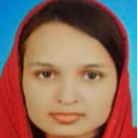
Arsha Kumari
Work place: Department of Electronic System Engineering, Mehran University of Engineering and Technology, Jamshoro, Sindh Pakistan
E-mail: arsharathi56@gmail.com
Website:
Research Interests: Computer systems and computational processes, Computational Learning Theory, Computer Vision, Computer Architecture and Organization
Biography
Arsha Kumari – She has completed her B.E in 2016 from the Department of Electronic Engineering Mehran University of Engineering Technology Jamshoro. Currently, she is doing her Master’s in Electronic System Engineering from Mehran UET Jamshoro. She has done many internships related to her field from which she learnt a lot. Her research interests include Machine Learning, Computer Vision, and Deep Learning.
Author Articles
Fuzzy Logic Based PID Auto Tuning Method of QNET 2.0 VTOL
By Murk Junejo Arbab Nighat Kalhoro Arsha Kumari
DOI: https://doi.org/10.5815/ijitcs.2020.01.02, Pub. Date: 8 Feb. 2020
Unmanned aerial vehicles (UAVs) have gained a lot of attention from researchers due to their hovering and vertical take-off and landing. Different techniques and methods are being employed to imple-ment UAVs. The QNET 2.0 VTOL board, specially de-signed for NI ELVIS II, is an important platform in the field of unmanned aerial vehicles (UAV). It is a helpful tool to demonstrate the essentials of vertical take-off and landing flight control (VTOL) at educational institutes. The PID controller installed in QNET 2.0 VTOL board is manually tuned is usually done by a skilled operator. This process of tuning is time-consuming and requires an expert’s knowledge. Although PID control of various sys-tems has been reported in the literature, its use is limited in nonlinear systems. For nonlinear systems. Fuzzy logic is suitable due to its nonlinearity capability. The purpose of this research is to study the dynamics of the QNET 2.0 VTOL model, simulate the flight control model in Lab-VIEW and to design an auto-tuned PID controller using Fuzzy logic for QNET 2.0 VTOL model in LabVIEW environment. This study shows that Fuzzy based auto-tuned PID controller controls the pitch angle of the QNET 2.0 VTOL model and gives promising results as compared to the existing PID controller in terms of auto-tuning in real-time and stability of the system.
[...] Read more.Off-line Sindhi Handwritten Character Identification
By Arsha Kumari Din Muhammad Sangrasi Sania Bhatti Bhawani Shankar Chowdhry Sapna Kumari
DOI: https://doi.org/10.5815/ijitcs.2019.06.02, Pub. Date: 8 Jun. 2019
Handwritten Identification is an ability of the computer to receive and translate the intelligible handwritten text into machine-editable text. It is classified into two types based on the way input is given namely: off-line and online. In Off-line handwritten recognition, the input is given in the form of the image while in online input is entered on a touch screen device. The research on off-line and online handwritten Sindhi character identification is on its very initial stage in comparison to other languages. Sindhi is one of the subcontinent's oldest languages with extensive literature and rich culture. Therefore, this paper aims to identify off-line Sindhi handwritten characters. In the proposed work, major steps involve in characters identification are training and testing of the system. Training is performed using a feed-forward neural network based on the efficient accelerative technique, the Back Propagation (BP) learning algorithm with momentum term and adaptive learning rate. The dataset of 304 Sindhi handwritten characters is collected from 16 different Sindhi writers, each with 19 characters. The novelty of proposed work is the comparison of the recognition rate for the single character, two characters and three characters at a time. Results showed that the recognition rate achieved for a single character is more than the recognition rate of multiple characters at a time.
[...] Read more.Other Articles
Subscribe to receive issue release notifications and newsletters from MECS Press journals